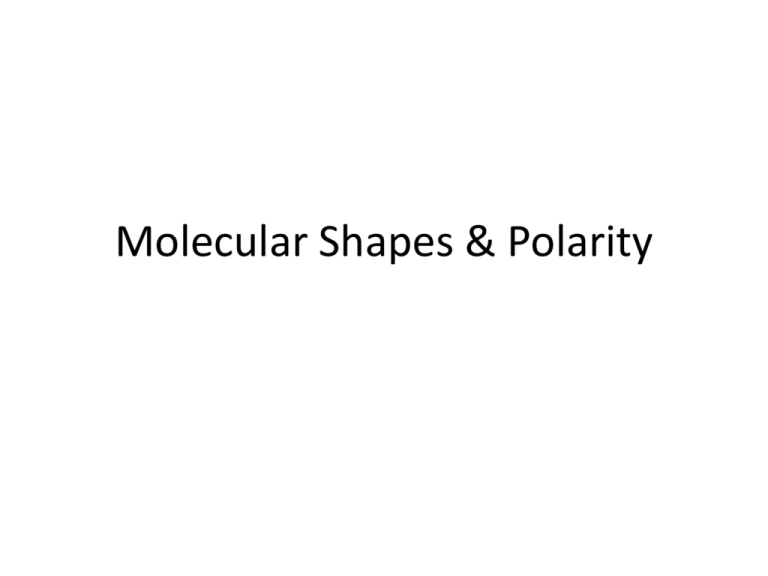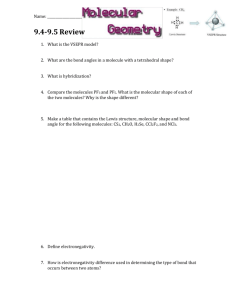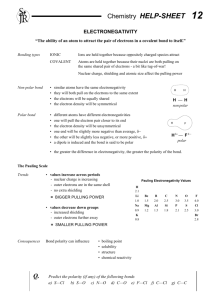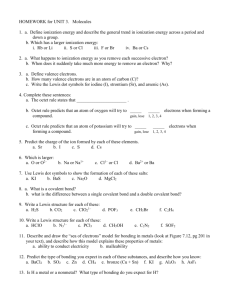Molecular Shapes & Polarity molecular_shapes__polarity
advertisement

Molecular Shapes & Polarity The Valence shell electron pair repulsion theory – VSEPR Theory • The shape of a molecule or ion is governed by the arrangement of the electron pairs around the central atom. • The pairs (sets) of electrons arrange themselves to produce the minimum amount of repulsion between them. • You have to consider both bonding pairs and lone pairs around the central atom. Four electron pairs around the central atom • The simplest is methane, CH4. Determine its Lewis dot diagram. • Four electron pairs arrange themselves in space in what is called a tetrahedral arrangement. A tetrahedron is a regular triangularly-based pyramid. The carbon atom would be at the centre and the hydrogens at the four corners. All the bond angles are 109.5°. • Build CH4 & draw it. Other examples with four electron pairs around the central atom • Ammonia, NH3 – Determine it dot diagram • Nitrogen is only forming 3 bonds, one of the pairs must be a lone pair. The electron pairs arrange themselves in a tetrahedral fashion as in methane. • Build NH3 & draw it. An Additional Factor • Lone pairs are in orbitals that are shorter and rounder than the orbitals that the bonding pairs occupy. Because of this, there is more repulsion between a lone pair and a bonding pair than there is between two bonding pairs. • That forces the bonding pairs together slightly - reducing the bond angle from 109.5° to 107°. Remember this: • Greatest repulsion lone pair - lone pair • lone pair - bond pair • Least repulsion bond pair - bond pair • When you describe the shape, you only take notice of the atoms. Lone pairs are ignored although they influence the shape. • Ammonia is pyramidal - like a pyramid with the three hydrogens at the base and the nitrogen at the top. Water, H2O • Draw the dot diagram for H2O • Following the same logic as before, you will find that the oxygen has four pairs of electrons, two of which are lone pairs. • These will again take up a tetrahedral arrangement. This time the bond angle closes slightly more to 104°, because of the repulsion of the two lone pairs. • The shape isn't described as tetrahedral, because we only "see" the oxygen and the hydrogens not the lone pairs. Water is described as bent or V-shaped. Molecular Shapes Quiz Formal Central Central Dot Formula Shared Unshared Shape Diagram Sets Sets (& why?) NF3 H2S NO2-1 Electronegativity • Electronegativity is the ability of an atom to attract electrons to form a chemical bond. An atom's electronegativity is related to its electron affinity and ionization energy. • Electron affinity is the amount of energy that is liberated by a gaseous element when an electron is added to it. • Ionization energy is the smallest amount of energy required to remove the most weakly bond electron from an atom of a gas. What happens if two atoms of equal electronegativity bond together? • Consider a bond between two atoms, A and B. Each atom may be forming other bonds as well as the one shown - but these are irrelevant to the argument. • If the atoms are equally electronegative, both have the same tendency to attract the bonding pair of electrons, and so it will be found on average half way between the two atoms. To get a bond like this, A and B would usually have to be the same atom. You will find this sort of bond in, for example, H2 or Cl2 molecules. • This sort of bond could be thought of as being a "pure" covalent bond where the electrons are shared evenly between the two atoms. What happens if B is slightly more electronegative than A? • B will attract the electron pair rather more than A does. • That means that the B end of the bond has more than its fair share of electron density and so becomes slightly negative. At the same time, the A end (rather short of electrons) becomes slightly positive. In the diagram, “d" (read as "delta") means "slightly" - so d+ means "slightly positive". Defining polar bonds • This is described as a polar bond. A polar bond is a covalent bond in which there is a separation of charge between one end and the other - in other words in which one end is slightly positive and the other slightly negative. Examples include most covalent bonds. The hydrogen-chlorine bond in HCl or the hydrogen-oxygen bonds in water are typical. Side 10 Chapter 20 Soaps & Detergents • • • • • Polar Nonpolar Hydrophilic Hydrophobic micelle • (fear of water) doesn’t dissolve in water • molecule with no charges • (water loving) dissolves in water • molecule with partial (+) & (-) charges • When soap molecules surround a oil drop with their hydrophobic tails inside & hydrophilic heads outside What happens if B is a lot more electronegative than A? • In this case, the electron pair is dragged right over to B's end of the bond. To all intents and purposes, A has lost control of its electron, and B has complete control over both electrons. Ions have been formed. A "spectrum" of bonds • The implication of all this is that there is no clear-cut division between covalent and ionic bonds. In a pure covalent bond, the electrons are held on average exactly half way between the atoms. In a polar bond, the electrons have been dragged slightly towards one end. • How far does this dragging have to go before the bond counts as ionic? There is no real answer to that. You normally think of sodium chloride as being a typically ionic solid, but even here the sodium hasn't completely lost control of its electron. Because of the properties of sodium chloride, however, we tend to count it as if it were purely ionic. Summary • No electronegativity difference between two atoms leads to a pure non-polar covalent bond. • A small electronegativity difference leads to a polar covalent bond. • A large electronegativity difference leads to an ionic bond. Polar bonds and polar molecules • In a simple molecule like HCl, if the bond is polar, so also is the whole molecule. What about more complicated molecules? • In CCl4, each bond is polar. • The molecule as a whole, however, isn't polar - in the sense that it doesn't have an end (or a side) which is slightly negative and one which is slightly positive. The whole of the outside of the molecule is somewhat negative, but there is no overall separation of charge from top to bottom, or from left to right. By contrast, CHCl3 is polar. • The hydrogen at the top of the molecule is less electronegative than carbon and so is slightly positive. This means that the molecule now has a slightly positive "top" and a slightly negative "bottom", and so is overall a polar molecule. • A polar molecule will need to be "lop-sided" in some way. Patterns of electronegativity in the Periodic Table • The most electronegative element is fluorine. If you remember that fact, everything becomes easy, because electronegativity must always increase towards fluorine in the Periodic Table. Polarity & Solubility Quiz Formula NH3 CS2 (EN,,d) Dot Formal Diagram Shape (EN,,d) Name (why?) Polar or Soluble in Nonpolar? water or oil? Side 6 Chapter 20 Solutions – Ion-Dipole Interactions & Solvation • Ion = charged particle (atom or combination of atoms) • Dipole = 2 poles of molecule, (-) & (+) • Ion – dipole interaction = Example: water molecules pulling apart the NaCl crystal and surrounding each ion “solvation” • Solute = substance being dissolved (lesser ingredient) Ex: salt • Solvent = usually a liquid that dissolves the solute (major ingredient) Ex: water Side 6 Chapter 30 Polar & Nonpolar Solvents • • • • • • • • Immiscible = will not mix or dissolve Miscible = will mix or dissolve H20 polar Carbon tetrachloride? CCl4 symmetrical & nonpolar “Like dissolves like” I2 dissolves in CCl4 CuCl2 dissolves in H2O








